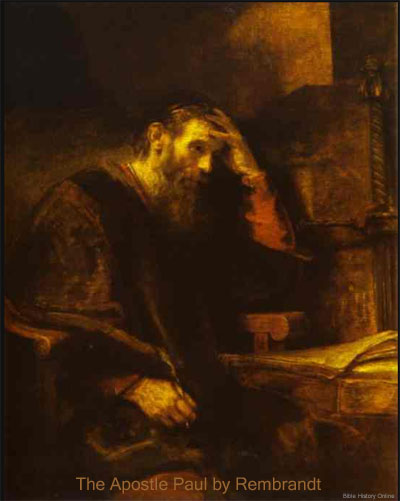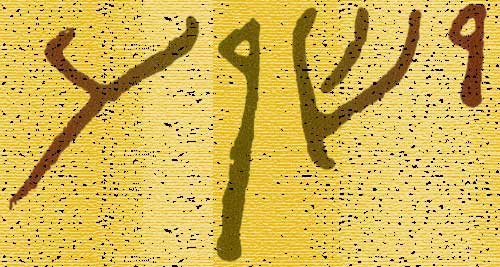Philemon 1:4-5 - I thank my God, making mention of thee always in my prayers, Hearing of thy love and faith, which thou hast toward the Lord Jesus, and toward all saints;
Philemon 1:9-10 - Yet for love's sake I rather beseech [thee], being such an one as Paul the aged, and now also a prisoner of Jesus Christ. I beseech thee for my son Onesimus, whom I have begotten in my bonds:
Philemon in The New Testament - A Brief Overview
The New Testament - A Brief Overview
| Outline of the Book of Philemon Scriptures and Topics Covered: Paul Commends Philemon - Chapter 1:1-7 Paul Intercedes for Onesimus - Chapter 1:8-21 Final Words - Chapter 1:22-25 |

Painting of Paul the Apostle by Rembrandt - 1657
Introduction to The Book of Philemon
Brief Summary. The Apostle Paul was in Rome preaching in "his own hired house." Onesimus was a runaway slave from Colossae in Asia Minor, and he met Paul who led him to Jesus Christ. There is a chance he could have known Paul previously for his master Philemon was a disciple of Christ. the crime of a slave running away from his master was punishable by death. The epistle to Philemon is a plea from the apostle Paul to receive his slave as a brother, as Christ had received Philemon.
Summary of The Book of PhilemonEpistle. The book of Philemon is considered by most scholars to be a companion letter to his epistle to the Colossians. This is because of the information in the book concerning Onesimus who had comforted Paul while he was in prison ( Philemon 1:11). Onesimus is mentioned in the book of Colossians as "one of you." He was being sent with both letters, along with Tychichus.
Author. Philemon and Colossians were both written by Paul the apostle.
Date. The book of Philemon as well as the book of Colossians were written by Paul and delivered at the same time. Since Colossians was written from Rome during Paul's first imprisonment 62 AD., the same must be believed about Philemon.
Philemon. The epistle was intended for Philemon, who may have been an elder in the church at Colossae. There is no doubt that he was a leader in the church, the church met at his home ( Philemon 1:2). Paul was familiar not only with Philemon but Apphia and Archippus who were members of his family, and he send greetings to them. Philemon appears to be a kind man, hospitable, and possibly wealthy. He seems to of been a good friend of the apostle Paul, he was with Paul as a worker, and did much for the church in Paul's absence.
Onesimus. Onesimus had been a slave of Philemon who had escaped, probably with some money. (Philemon1:18). He showed up in Rome to find refuge and came in contact with the apostle Paul who led him to Christ. Once Onesimus became a Christian he became close to Paul and also a great source of help. Paul appreciated Onesimus but believed that he should return to his master and encouraged him to do so. When Onesimus returned Philemon had the legal right to slay his disobedient slave, for this crime was punishable by death in the Roman Empire. It is clearly seen that Paul becomes an advocate of Onesimus in this letter to Philemon.
Paul. The epistle to Philemon shows a lot about the apostle Paul, for he cared much about each circumstance that God led him into. He cared as much about the situation with Onesimus as he did with the heresies that brought so much trouble to the church at Colossae. It is interesting that Paul even wrote this letter with his own hand to show how important it was to him.
Outline of the Book of Philemon
Paul Commends Philemon - Chapter 1:1-7
Paul Intercedes for Onesimus - Chapter 1:8-21
Final Words - Chapter 1:22-25

The Name Jesus In Ancient Hebrew Text
"Yeshua" in First Century Hebrew Text. This is how the name "Jesus" would have
been written in ancient Hebrew documents. The four letters or consonants from
right to left are Yod, Shin, Vav, Ayin (Y, SH, OO, A). Jesus is the Greek name
for the Hebrew name Joshua or Y'shua which means "The LORD or Yahweh is
Salvation".
Philemon Maps and Resources
Map of the Roman Empire (14 A.D.) - This map reveals the Roman Empire during the time shortly after the birth of Jesus, in 14 AD at the time of the death of Augustus. The order which prevailed in this extensive empire, the good military roads, and the use of Koine Greek as the general language of culture throughout the area were among the factors which multiplied the rapid spread of the Gospel of Jesus Christ. (Color Map)
Map of Paul's First Missionary Journey (48 A.D.) - This map reveals the areas in Asia Minor where Paul visited in his first missionary journey. Around 48 AD, in the springtime, Paul and his companions Barnabas and Mark were sent on a mission from the church in Antioch. This would be the first of Paul's Missionary Journey's. (Color Map)
Map of Paul's Second Missionary Journey (51 A.D.) - This map reveals the areas in Asia and Greece where Paul visited in his second missionary journey. Paul re-visits a couple cities in Asia, one of which was Lystra where he was stoned and left for dead a few years earlier. He later has a vision that leads him over to Greece and Paul and his companions travel and minister in various cities in Greece (Philippi, Thessalonica, Berea, Athens and Corinth. Later Paul returns to Ephesus and finally to Caesarea and Antioch. (Color Map)
Map of Paul's Third Missionary Journey (54 A.D.) - This map reveals the areas in Asia and Greece where Paul visited in his third missionary journey. On Paul's third missionary journey he returned to the cities he had first visited on his first missionary journey. During this time he decided to remain in Ephesus for about 3 years, and this city was the main focus of his activities and an important Christian community (Acts 19). (Color Map)
Map of the New Testament World - This map reveals the "Nations" within the ancient world during the first century A.D., the time of the New Testament. The map includes the areas of Israel, Asia, Greece, and Italy. (Color Map)
Map of New Testament Greece This map reveals the cities within Greece in the ancient world during the first century A.D.,The map includes the principal cities of Greece like: Athens, Corinth, and Thessalonica, and provinces like Macedonia and Achaia. (Color Map)
Map of New Testament Asia - This map shows the cities within Asia Minor during the first century A.D., the time of the New Testament. The map includes the principal cities of Asia including Tarsus, Ephesus, and Colossae, and provinces like Galatia and Pamphilia. (Color Map)
Read The Bible
- 1599 Geneva Bible (GNV)
- 21st Century King James Version (KJ21)
- American Standard Version (ASV)
- Amplified Bible (AMP)
- Amplified Bible, Classic Edition (AMPC)
- Authorized (King James) Version (AKJV)
- BRG Bible (BRG)
- Christian Standard Bible (CSB)
- Common English Bible (CEB)
- Complete Jewish Bible (CJB)
- Contemporary English Version (CEV)
- Darby Translation (DARBY)
- Disciples’ Literal New Testament (DLNT)
- Douay-Rheims 1899 American Edition (DRA)
- Easy-to-Read Version (ERV)
- English Standard Version (ESV)
- English Standard Version Anglicised (ESVUK)
- Evangelical Heritage Version (EHV)
- Expanded Bible (EXB)
- GOD’S WORD Translation (GW)
- Good News Translation (GNT)
- Holman Christian Standard Bible (HCSB)
- International Children’s Bible (ICB)
- International Standard Version (ISV)
- J.B. Phillips New Testament (PHILLIPS)
- Jubilee Bible 2000 (JUB)
- King James Version (KJV)
- Lexham English Bible (LEB)
- Living Bible (TLB)
- Modern English Version (MEV)
- Mounce Reverse Interlinear New Testament (MOUNCE)
- Names of God Bible (NOG)
- New American Bible (Revised Edition) (NABRE)
- New American Standard Bible (NASB)
- New American Standard Bible 1995 (NASB1995)
- New Catholic Bible (NCB)
- New Century Version (NCV)
- New English Translation (NET)
- New International Reader's Version (NIRV)
- New International Version - UK (NIVUK)
- New International Version (NIV)
- New King James Version (NKJV)
- New Life Version (NLV)
- New Living Translation (NLT)
- New Matthew Bible (NMB)
- New Revised Standard Version (NRSV)
- New Revised Standard Version Catholic Edition (NRSVCE)
- New Revised Standard Version, Anglicised (NRSVA)
- New Revised Standard Version, Anglicised Catholic Edition (NRSVACE)
- New Testament for Everyone (NTE)
- Orthodox Jewish Bible (OJB)
- Revised Geneva Translation (RGT)
- Revised Standard Version (RSV)
- Revised Standard Version Catholic Edition (RSVCE)
- The Message (MSG)
- The Voice (VOICE)
- Tree of Life Version (TLV)
- World English Bible (WEB)
- Worldwide English (New Testament) (WE)
- Wycliffe Bible (WYC)
- Young's Literal Translation (YLT)
Table of Contents
Main Menu
- Ancient Assyrian Social Structure
- Ancient Babylonia
- Ancient Canaan During the Time of Joshua
- Ancient History Timeline
- Ancient Oil Lamps
- Antonia Fortress
- Archaeology of Ancient Assyria
- Assyria and Bible Prophecy
- Augustus Caesar
- Background Bible Study
- Bible
- Biblical Geography
- Fallen Empires - Archaeological Discoveries and the Bible
- First Century Jerusalem
- Glossary of Latin Words
- Herod Agrippa I
- Herod Antipas
- Herod the Great
- Herod's Temple
- High Priest's in New Testament Times
- Jewish Literature in New Testament Times
- Library collection
- Map of David's Kingdom
- Map of the Divided Kingdom - Israel and Judah
- Map of the Ministry of Jesus
- Matthew Henry Bible Commentary
- Messianic Prophecy
- Nero Caesar Emperor
- Online Bible Maps
- Paul's First Missionary Journey
- Paul's Second Missionary Journey
- Paul's Third Missionary Journey
- Pontius Pilate
- Questions About the Ancient World
- Tabernacle of Ancient Israel
- Tax Collectors in New Testament Times
- The Babylonian Captivity
- The Black Obelisk of Shalmaneser
- The Books of the New Testament
- The Court of the Gentiles
- The Court of the Women in the Temple
- The Destruction of Israel
- The Fall of Judah with Map
- The History Of Rome
- The Incredible Bible
- The Jewish Calendar in Ancient Hebrew History
- The Life of Jesus in Chronological Order
- The Life of Jesus in Harmony
- The Names of God
- The New Testament
- The Old Testament
- The Passion of the Christ
- The Pharisees
- The Sacred Year of Israel in New Testament Times
- The Samaritans
- The Scribes
Ancient Questions
- Why Do the Huldah Gates Appear Different in Ancient Replicas and Modern Photos?
- What Is the Origin of the Japanese and Chinese Peoples? A Biblical Perspective
- How did the ancient Greeks and Romans practice medicine and treat illnesses?
- What were the major contributions of ancient Babylon to mathematics and astronomy?
- How did the ancient Persians create and administer their vast empire?
- What were the cultural and artistic achievements of ancient India, particularly during the Gupta Empire?
- How did ancient civilizations like the Incas and Aztecs build their remarkable cities and structures?
- What were the major trade routes and trading practices of the ancient world?
- What was the role of slavery in ancient societies like Rome and Greece?
- How did the ancient Mayans develop their sophisticated calendar system?
Bible Study Questions
- Why Do Christians Celebrate Christmas?
- How Many Chapters Are There in the Bible?
- The Five Key Visions in the New Testament
- The 400-Year Prophecy: Unpacking Genesis 15 and the Journey of a People
- The Authorized (King James) Version (AKJV): Historical Significance, Translation Methodology, and Lasting Impact
- Exploring the English Standard Version (ESV): Its Aspects, Comparisons, Impact on Biblical Studies, and Church Use
- A Detailed Historical Analysis of Language Updates in the KJ21: Comparison with Other Versions
- A Detailed Historical Analysis of the American Standard Version (ASV): Comparison to the King James Version, Influence on Later Translations, and Evaluation of Strengths and Weaknesses
- A Detailed Historical Analysis of Amplifications in the Amplified Bible (AMP) and Its Comparison to Other Bible Translations
- Detailed Historical Analysis of the Amplified Bible Classic Edition (AMPC): Examples of Amplifications and Comparative Analysis with Other Bible Translations
About
Welcome to Free Bible: Unearthing the Past, Illuminating the Present! Step into a world where ancient history and biblical narratives intertwine, inviting you to explore the rich tapestry of human civilization.
Discover the captivating stories of forgotten empires, delve into the customs and cultures of our ancestors, and witness the remarkable findings unearthed by dedicated archaeologists.
Immerse yourself in a treasure trove of knowledge, where the past comes alive and illuminates our understanding of the present.
Join us on this extraordinary journey through time, where curiosity is rewarded and ancient mysteries await your exploration.
Recent posts
-

Do Scientists Believe in God? Faith and Science in the 21st Century
For centuries, people have debated whether science and faith can go hand in hand. Some argue that science should rely only on what can be measured and... -

Listening Deeper: Ekaterina Fakhrutdinova on How Soul Care Becomes a New Culture of Care
Author: Susan Perk Date: 24 Sep 2025 When faith is not dogma, but dialogue. And when psychology is not diagnosis, but service. Today, Christian psycho... -

The Vital Role of Christian Translation Ministries in Spreading the Gospel
The Gospel is for every tribe, tongue, and nation. Yet, millions of people around the world still cannot access Scripture in their own language. This ... -

The Vision of Clarity: Why Elegant Glasses Are the Perfect Choice for Modern Living
For centuries, vision has been associated not only with physical sight but also with wisdom, clarity, and perspective. In the modern world, where appe... -

Dallas Jeweler Bedig Minassian Launches Charitable Project Mother Holding Child (ALOUUM)
Dallas is a city that thrives on innovation, creativity, and community spirit. Few embody that combination better than Bedig Minassian, a well-known D...